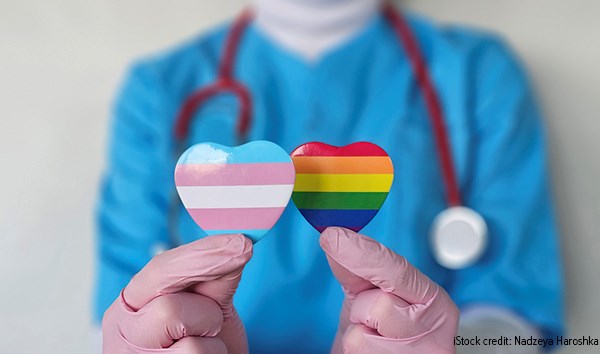Transgender Health in the ED
Emergency departments (ED) across the United States often act as safety nets for vulnerable populations. Among them are individuals who identified as transgender or gender non-conforming (TGGNC). TGGNC individuals have higher rates of developing anxiety, depression, eating disorders, and chronic diseases. They also have higher rates of experiencing violence and sexual assault, as well as suicidal ideations and attempts.
In one study, 81% of people who identified as transgender stated that they had experienced suicidal ideations at some point in their lives. In the same study, 42% shared how they have attempted to take their own lives, which is significantly higher than the national average. TGGNC individuals continue to face significant barriers when navigating the health care system. Many TGGNC individuals choose not to seek care due to previous negative experiences in the ED, leading to delays in treatment or complete avoidance of healthcare altogether.
A qualitative report by Chisolm-Straker et al evaluated the reasons why members of the TGGNC community avoid the ED, what their experiences are like if they seek care in the ED, and what emergency medicine physicians can do to improve delivery of quality care. The authors surveyed 240 TGGNC individuals to understand reasons for utilizing the ED, overall experiences in the ED, and recommendations to ED clinicians regarding gender-affirming care.
The participants described both positive and negative experiences in the ED. Prior negative experiences with an ED clinician and fear of discrimination were reported as the main reasons impacting TGGNC individuals' ability and willingness to seek and receive medical care, leading to delayed or forgone treatment. Other reasons given for not seeking care include:
- Lack of accommodations
- Staff refusal to use preferred pronouns
- Being uninsured
- Medical personnel gossiping or mocking TGGNC patients outside their rooms
Regarding positive experiences, participants often commented on the clinician's competency and knowledge about TGGNC life experiences.
Overall, this study captures the general satisfaction of the experience of TGGNC individuals in EDs, though most respondents were transgender men and White. understanding and find areas of intervention.
In conclusion, this study highlights he importance of correct pronounce usage, the need for more research on TGGC experiences in the emergency department, and the development of standardized training and ED-specific guidelines for the care of TGGC patients.
Abstract
Chisolm-Straker M, Jardine L, Bennouna C, Morency-Brassard N, Coy L, Egemba MO, Shearer PL. Transgender and nonconforming in emergency departments: a qualitative report of patient experiences. Transgend Health. 2017;2(1):8-16.
Background
Individuals who have a transgender or gender nonconforming (TGGNC) experience belong to a marginalized segment of the U.S. population, and healthcare can be difficult for them to navigate. Although emergency departments (EDs) traditionally serve as healthcare "safety nets" for vulnerable populations, quantitative studies outside the United States have found that TGGNC-experienced persons tend to avoid EDs and/or have negative experiences. This qualitative study primarily describes the ED experiences of people with a TGGNC history; furthermore, the study explores reasons why this population avoids U.S. EDs and their recommendations for improvements to ED care.
Methods
This qualitative study used data about TGGNC-historied persons' experiences in U.S. EDs from retrospective, anonymous, written surveys (paper or web based). National data collection took place from June 2012 through December 2014. Participant responses (n=240) were examined using thematic analysis.
Results
Using a framework that recognized positive and negative responses, the themes of Self-Efficacy and Power Inequity surfaced. These themes exposed the tension between patients with TGGNC experiences and clinicians who were perceived to lack training in this area, resulting in negative patient experiences. When practitioners had specific training about this population, participants reported positive care experiences.
Conclusions
This study indicates that many TGGNC-historied persons who use U.S. EDs have negative experiences, largely due to lack of clinician sensitivity toward and training about this patient population. Data from this investigation suggest that training of U.S. ED health care teams and institutional support would help.
EMRA + PolicyRx Health Policy Journal Club: A collaboration between Policy Prescriptions and EMRA
 As emergency physicians, we care for all members of society, and as such have a unique vantage point on the state of health care. What we find frustrating in our EDs - such as inadequate social services, the dearth of primary care physicians, and the lack of mental health services - are universal problems. As EM residents and fellows, we learn the management of myocardial infarctions and traumas, and how to intubate, but we are not taught how health policy affects all aspects of our experience in the ED. Furthermore, given our unique position in the health care system, we have an incredible opportunity to advocate for our patients, for society, and for physicians. Yet, with so many competing interests vying for our conference education time, advocacy is often not included in the curricula. This is the gap this initiative aims to fill. Each month, you will see a review of a new health policy article and how it is applicable to emergency physicians.
As emergency physicians, we care for all members of society, and as such have a unique vantage point on the state of health care. What we find frustrating in our EDs - such as inadequate social services, the dearth of primary care physicians, and the lack of mental health services - are universal problems. As EM residents and fellows, we learn the management of myocardial infarctions and traumas, and how to intubate, but we are not taught how health policy affects all aspects of our experience in the ED. Furthermore, given our unique position in the health care system, we have an incredible opportunity to advocate for our patients, for society, and for physicians. Yet, with so many competing interests vying for our conference education time, advocacy is often not included in the curricula. This is the gap this initiative aims to fill. Each month, you will see a review of a new health policy article and how it is applicable to emergency physicians.



